|
Edomites Advance into Judah
Tel Aviv
University News
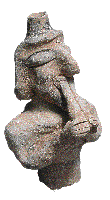 The
Bible tells us that the Edomites were Israel's bitter
enemies, yet little else is known about this enigmatic
people who lived southeast of the Dead Sea. Recent TAU
excavations have, however, unearthed archeological evidence
for Edomite hostilities. TAU archeologist Prof. Yitzhaq
Beit-Arieh examines the implications of Edomite objects
recently uncovered in the heart of ancient Judah. The
Bible tells us that the Edomites were Israel's bitter
enemies, yet little else is known about this enigmatic
people who lived southeast of the Dead Sea. Recent TAU
excavations have, however, unearthed archeological evidence
for Edomite hostilities. TAU archeologist Prof. Yitzhaq
Beit-Arieh examines the implications of Edomite objects
recently uncovered in the heart of ancient Judah.
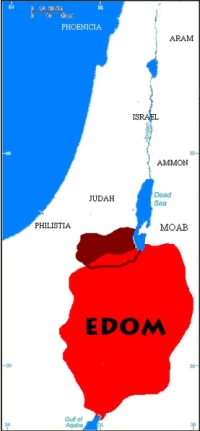 The
origins of the Edomites, like those of the early Israelites,
remain obscure. They appear to have emerged as a people
about the same time as the Israelites during the Iron Age I
period (12 - 13th centuries BCE). The
origins of the Edomites, like those of the early Israelites,
remain obscure. They appear to have emerged as a people
about the same time as the Israelites during the Iron Age I
period (12 - 13th centuries BCE).
The land of Edom lay in present-day southern Jordan, bounded
on the north by Wadi Hasa (biblical Nahal Zered) at the
southern end of the Dead Sea, and extending south to the
Gulf of Eilat. In the Bible, Edom is closely linked to the
region known as Seir, where Esau, the commonly accepted
father of the Edomites, dwelt (Genesis 36:8-9; Deuteronomy
2:4-5, 22, 29).
Unique Edomite pottery finds
 Unlike
the Israelites, however, the Edomites have left us no
literature comparable to the Bible, leaving archeologists to
rely on material evidence to piece together their history.
The first examples of red Edomite pottery were discovered in
1940 by American rabbi and archaeologist Nelson Glueck, at
Tel el-Kheleifeh, a few miles north of the Gulf of Eilat, in
modern Jordan. The unique style of the pottery indicates
that the Edomites had developed their own independent
culture. Unlike
the Israelites, however, the Edomites have left us no
literature comparable to the Bible, leaving archeologists to
rely on material evidence to piece together their history.
The first examples of red Edomite pottery were discovered in
1940 by American rabbi and archaeologist Nelson Glueck, at
Tel el-Kheleifeh, a few miles north of the Gulf of Eilat, in
modern Jordan. The unique style of the pottery indicates
that the Edomites had developed their own independent
culture.
The Edomite finds also included ostraca (potsherds with
inscriptions) which puzzled archeologists since some letters
differed from contemporary Hebrew script. Similar script was
found on jar handles which had been impressed with a seal.
The seal mentions the principal Edomite deity Qos.
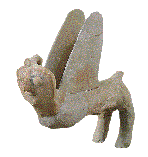 The
Bible tells us that Judah and Edom were at loggerheads for
many years, probably over control of the strategic coastal
area north of the Gulf of Eilat, and Tel el-Kheleifeh
appears to have been the most important Edomite site in the
region since it controlled the gateway to the southern seas,
Africa, the Arabian peninsula and beyond. The
Bible tells us that Judah and Edom were at loggerheads for
many years, probably over control of the strategic coastal
area north of the Gulf of Eilat, and Tel el-Kheleifeh
appears to have been the most important Edomite site in the
region since it controlled the gateway to the southern seas,
Africa, the Arabian peninsula and beyond.
Red Edomite pottery dating from the Israelite period,
seventh century BCE, has been found at numerous other sites
in the Israeli Negev desert. At Horvat Qitmit, in the
eastern Negev, archeologists of TAU's Sonia and Marco Nadler
Institute of Archeology, led by Prof. Yitzaq Beit-Arieh,
uncovered an Edomite shrine where more than 800 figurines,
anthropomorphic stands, reliefs and other items including
three incomplete inscriptions bearing the name, Qos, were
found.
Biblical enemies
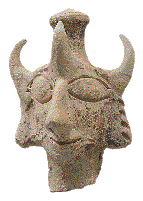 The
Bible amply documents the intense enmity between the
Edomites and the Israelites. Numbers 20 relates how the
Edomites would not allow the Israelites to pass through
their territory on the way from Egyptian bondage to the
Promised Land. Both King Saul and King David fought against
the Edomites (1 Samuel 14; 1 Kings 11). The
Bible amply documents the intense enmity between the
Edomites and the Israelites. Numbers 20 relates how the
Edomites would not allow the Israelites to pass through
their territory on the way from Egyptian bondage to the
Promised Land. Both King Saul and King David fought against
the Edomites (1 Samuel 14; 1 Kings 11).
Scholars, among them Prof. Beit-Arieh, believe that after
the destruction of Solomon's Temple by the Babylonians in
586 BCE, the Edomites took advantage of the situation to
expand into a severely weakened Judah.
The Biblical account of this expansion into the Negev can
now be backed up by mounting archeological evidence. The
Edomite shrines at Horvat Qitmit, 'Ein Hatzeva and in the
Arava, with their extraordinary cult objects, may mark the
path of the Edomite expansion into Judah. In any event, they
clearly indicate an Edomite presence in the region
connecting Edom and Judah.
Recent excavations unearthed at Tel Malhata, about 3 miles
north-west of Qitmit, by the TAU team together with
archeologists from Baylor University, Texas, suggest that
for a short period the site was a center of an Edomite
occupation of the eastern Negev in Judah. Perhaps the most
dramatic find is a figurine of a flute player with a
double-stemmed flute. Its amazing resemblance both in style
and technique to a three-horned goddess found at the Edomite
shrine at Qitmit makes it is virtually certain that the two
figurines were produced in the same workshop - most probably
at Tel Malhata. The vast material at these two sites
indicate Edomite domination of the region at the end of the
First Temple period.
On the defensive
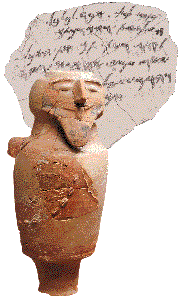 This
new evidence of Edomite expansion into Judah also helps
explain the presence of a series of Israelite defense
fortresses found at Horvat Uza, Horvat HaDrom, Horvat Anim,
Horvat Tov and Arad during the seventh century BCE. Although
archeologists have long known that a line of fortified
Israelite outposts was erected in the eastern Negev at about
this time, the reason for the protective barrier remained a
mystery. It is now possible to affirm that these fortresses
were built to protect against Edomite invasions, backing up
the Biblical references to the conflict between the two
peoples with concrete archeological evidence. This
new evidence of Edomite expansion into Judah also helps
explain the presence of a series of Israelite defense
fortresses found at Horvat Uza, Horvat HaDrom, Horvat Anim,
Horvat Tov and Arad during the seventh century BCE. Although
archeologists have long known that a line of fortified
Israelite outposts was erected in the eastern Negev at about
this time, the reason for the protective barrier remained a
mystery. It is now possible to affirm that these fortresses
were built to protect against Edomite invasions, backing up
the Biblical references to the conflict between the two
peoples with concrete archeological evidence.
"Here is an instance in which the Bible and archaeology
splendidly illuminate one another," says Prof. Beit-Arieh.
"The Biblical accounts of the relations between these 'unneighborly
neighbors' can now be confirmed in large part by
archaeological evidence."
Excerpts from the cover story of Biblical Archeology,
December, 1996, written by Prof. Yitzhaq Beit-Arieh.
http://www.tau.ac.il/taunews/97spring/edom.html
____________________________________________________
 The
Official
Tsiyon Road Android App 2.0 The
Official
Tsiyon Road Android App 2.0
Click image to
download app from Google Play
Easily
Listen to Tsiyon Road Messianic Radio from your Android device!
One listener says;
"Thanks for the new Tsiyon Road Android App. It makes it
SO easy for me to listen to all my favorite Tsiyon programs!"
________________________________________________________
 Tsiyon
Road on Glorystar Satellite! Tsiyon
Road on Glorystar Satellite!
Satellite coverage
for all of North America, Canada and much of South America. Glorystar has made an equipment package
available just for Tsiyon Road listeners. To find out more visit
our special Tsiyon Road page at:
http://tsiyon.glorystar.tv/
Need to talk to us? - In the USA and Canada just call us toll
free at (888) 230-2440 for help. Internationally, email us and we
will arrange a phone or Skype call for you.
From Eliyahu
The Rabbinical Jews say that Edom is synonymous with both Rome and
the Christians. At first blush that doesn't seem to make a lot of
sense - but do you know why they say that? I didn't, so I decided to
find out. I began digging in all manner of scholarly resources, both
ancient and modern, and the more I researched the more obsessed I
became. Happily, my hours of research paid off far beyond my wildest
dreams, as I unearthed a mountain of astounding information that has
remained hidden from most of us for years. As it turns out, the
influence of Esau - "Esau is Edom" - has gone far beyond that dried
out rock Edom once called home. Just how far beyond will blow your
mind! It is absolutely staggering to contemplate how the Edomites
continue to exert a powerful, and decidedly evil, influence in the
world, right down to our day. This 4 hour midrash blockbuster will
answer questions you never even knew you need to ask! Join me, for a
wild ride through history and a mind-expanding worldview adjustment,
this EBD Bet Midrash.
Blessings and
Shalom!
Eliyahu ben David
www.tsiyon.org
|
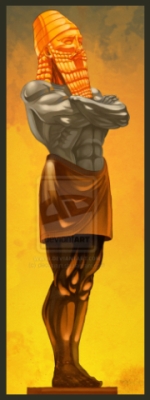 4 HOUR
MIDRASH BLOCKBUSTER!
4 HOUR
MIDRASH BLOCKBUSTER!







 The
Bible tells us that the Edomites were Israel's bitter
enemies, yet little else is known about this enigmatic
people who lived southeast of the Dead Sea. Recent TAU
excavations have, however, unearthed archeological evidence
for Edomite hostilities. TAU archeologist Prof. Yitzhaq
Beit-Arieh examines the implications of Edomite objects
recently uncovered in the heart of ancient Judah.
The
Bible tells us that the Edomites were Israel's bitter
enemies, yet little else is known about this enigmatic
people who lived southeast of the Dead Sea. Recent TAU
excavations have, however, unearthed archeological evidence
for Edomite hostilities. TAU archeologist Prof. Yitzhaq
Beit-Arieh examines the implications of Edomite objects
recently uncovered in the heart of ancient Judah. The
origins of the Edomites, like those of the early Israelites,
remain obscure. They appear to have emerged as a people
about the same time as the Israelites during the Iron Age I
period (12 - 13th centuries BCE).
The
origins of the Edomites, like those of the early Israelites,
remain obscure. They appear to have emerged as a people
about the same time as the Israelites during the Iron Age I
period (12 - 13th centuries BCE). Unlike
the Israelites, however, the Edomites have left us no
literature comparable to the Bible, leaving archeologists to
rely on material evidence to piece together their history.
The first examples of red Edomite pottery were discovered in
1940 by American rabbi and archaeologist Nelson Glueck, at
Tel el-Kheleifeh, a few miles north of the Gulf of Eilat, in
modern Jordan. The unique style of the pottery indicates
that the Edomites had developed their own independent
culture.
Unlike
the Israelites, however, the Edomites have left us no
literature comparable to the Bible, leaving archeologists to
rely on material evidence to piece together their history.
The first examples of red Edomite pottery were discovered in
1940 by American rabbi and archaeologist Nelson Glueck, at
Tel el-Kheleifeh, a few miles north of the Gulf of Eilat, in
modern Jordan. The unique style of the pottery indicates
that the Edomites had developed their own independent
culture. The
Bible tells us that Judah and Edom were at loggerheads for
many years, probably over control of the strategic coastal
area north of the Gulf of Eilat, and Tel el-Kheleifeh
appears to have been the most important Edomite site in the
region since it controlled the gateway to the southern seas,
Africa, the Arabian peninsula and beyond.
The
Bible tells us that Judah and Edom were at loggerheads for
many years, probably over control of the strategic coastal
area north of the Gulf of Eilat, and Tel el-Kheleifeh
appears to have been the most important Edomite site in the
region since it controlled the gateway to the southern seas,
Africa, the Arabian peninsula and beyond. The
Bible amply documents the intense enmity between the
Edomites and the Israelites. Numbers 20 relates how the
Edomites would not allow the Israelites to pass through
their territory on the way from Egyptian bondage to the
Promised Land. Both King Saul and King David fought against
the Edomites (1 Samuel 14; 1 Kings 11).
The
Bible amply documents the intense enmity between the
Edomites and the Israelites. Numbers 20 relates how the
Edomites would not allow the Israelites to pass through
their territory on the way from Egyptian bondage to the
Promised Land. Both King Saul and King David fought against
the Edomites (1 Samuel 14; 1 Kings 11). This
new evidence of Edomite expansion into Judah also helps
explain the presence of a series of Israelite defense
fortresses found at Horvat Uza, Horvat HaDrom, Horvat Anim,
Horvat Tov and Arad during the seventh century BCE. Although
archeologists have long known that a line of fortified
Israelite outposts was erected in the eastern Negev at about
this time, the reason for the protective barrier remained a
mystery. It is now possible to affirm that these fortresses
were built to protect against Edomite invasions, backing up
the Biblical references to the conflict between the two
peoples with concrete archeological evidence.
This
new evidence of Edomite expansion into Judah also helps
explain the presence of a series of Israelite defense
fortresses found at Horvat Uza, Horvat HaDrom, Horvat Anim,
Horvat Tov and Arad during the seventh century BCE. Although
archeologists have long known that a line of fortified
Israelite outposts was erected in the eastern Negev at about
this time, the reason for the protective barrier remained a
mystery. It is now possible to affirm that these fortresses
were built to protect against Edomite invasions, backing up
the Biblical references to the conflict between the two
peoples with concrete archeological evidence.
 Tsiyon
Road on Glorystar Satellite!
Tsiyon
Road on Glorystar Satellite!